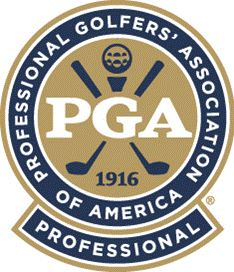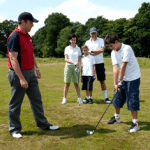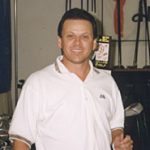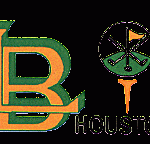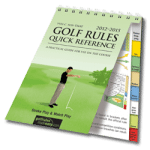Contents
- Driving the ball straight
- Getting on the PGA Tour
- Pulling the ball left
- Changing ball types
- Swing Plane
- Fat shots
- Missing short putts
- Hitting against the wind
- Hitting backspin on short shots
- Preventing a slice
- Heavier club
- Hitch in swing
- Proper shaft for driver
- Players passing the P.A.T.
- 7 wood
- Hitting the Driver
- Disconnected grip
- How to get on the PGA Tour
- How to put backspin on the ball
- Backspin on approach shots
- Weight training for golf
- Pushing with the driver
- Topping the ball
- Handicapping a skins tourney
- Hitting the ball farther
- Nike Tour
- Natural Golf instruction
- Related Articles on GolfSW.com
Driving the ball straight
Jason Berthoud of Nazareth, PA writes: Hi,my name is Jason and my dad (Charles) just got into golfing. Do you have any ideas on how we can can drive the ball off the tee straight?
Kim Brown: No simple answer to this question. However, a combination of good setup fundamentals and swing “path” are the key ingredients. The goals are to have the clubface pointing at the target at impact, the club “path” be swinging towards the target at impact, and to strike the ball just before the bottom of your swing (prior to taking a small divot on the irons).
Getting on the PGA Tour
Fredrik Ericson of Davie, FL writes: What age do (Most) of the PGA Tour Professionals get on Tour? What age did you get on Tour? Do all the Professionals get on Tour at the age of 20 like Tiger Woods, or is he just a phenom? I’d like to join the PGA Tour someday, I’m working real hard at it……so I’m hoping.
Kim Brown: Well, Fredrik —- Yes, Tiger Woods is a phenom! Most young players these days earn their way onto the tour through tour school. Most people that do succeed have had significant playing experience on mini tours, Nike Tour, etc.
You should continue to work very hard towards your goal, but don’t forget school work, etc. as only 50 players in the world earn their way onto the tour each year. . I am the President of the Northern Texas PGA, a PGA Master Professional, etc., etc. but have never played on the PGA Tour, for example. I can still beat most everybody I know – but that is still not good enough for the “tour”.
Seek out an outstanding person like a PGA Professional who can help you with your game and take every opportunity to play competitively. I wish you the best of luck.
Kim J. Brown
Pulling the ball left
Jared Bibbee in Salem, OH asks: How do you stop pulling the ball to the left?
Kim Brown: Jared, there are 2 main ways –
1) close your shoulders at address more (point them to the right)
2) Practice hitting balls with a glove under your left arm-keeps the hands working in conjunction with your shoulder turn better.
Changing ball types
Scott Martin in Palm Springs CA asks: Can you play a new ball every new hole? or do you have to finish your round with the same ball? Unless of course, its damaged and has been approved by your players to be replaced? For example short par 3 using a balata and for long par 5’s a nice hard cover ball.
Kim Brown: No. If the one ball rule is in effect, you cannot change type balls during the round. You can change the ball that you are playing between holes, but not during the play of a hole, unless you establish damage to the ball.
Swing Plane
Sean White of Amherstburg, Ontario writes: I’ve been told that my swing plane is to shallow on the downswing. Although I was under the impression that a flat swing such as Ben Hogan and Moe Norman were ideal in obtaining accurate golf shots. I am 6ft 1inches and weight 190 lbs. The golf ball has a tendency to hook yet I do push the shot every once in a while especially with my driver. Thanks!
Kim Brown: Check your shoulder alignment at address to see if your shoulders are too far open. Sounds like your “shallow” follow through may be trying to follow the alignment of your shoulders OR your hands may be a little too strong or too active. Good luck.
Kim
Fat shots
Michael Eagen of Olivet, MI writes: I am left-handed and I tend to hit my irons short. I often hit the ball fat. What causes a fat shot? Is there a drill I can do to make better contact?
Kim Brown: Yes, hit balls with a glove under your right arm with about a wedge or 9 iron. Will cause you to coil and uncoil as the goal is to not drop the glove throughout the swing or at least not until high into your follow through.
It will also coordinate the efforts of your BIG muscles (trunk) with your hands and arms. Hitting the ball fat is a result of your swing radius (your right arm, in your case) changing lengths during the swing which usually happens as a result of too active of hands and not enough coiling and uncoiling during the swing.
Kim J. Brown
Missing short putts
Darren Adams of Columbia, SC writes: Why am I always missing short putts?
Kim Brown: Tough one to answer in a generic way, BUT the answer is either incorrect fundamentals in list “a” or the mental aspects of the game in list “b” below:
“A” – use your “hands” too much, don’t putt utilizing the shoulders enough. Result is the putter does not stay on the intended target line long enough.
Setup – hold a ball directly under your dominate eye and drop it when in your putting stance. It should land real close to where your ball position is. If not, you may be standing too close or too far away from the ball at address.
Most folks putt poorly when “hands” move the putter to the left of the intended target line and then miss it left if the clubface closes and right if the clubface hangs open.
“B” – no confidence results in the putter decelerating through the impact area which results in “a” from above. I suggest practice putting from two feet using NO BACKSWING. Promotes acceleration through the ball AND getting the putter head on the target line.
Kim
Hitting against the wind
Albert in Irvine, CA asks: When hitting the ball against the wind, should one tee the ball up higher than usual, the same as usual, or lower than usual? And why or why not?
Kim Brown: I have found that teeing height is not the major determining factor of how low you are going to hit the ball. Obviously, I would lean towards teeing the ball slightly lower, however. The reason some people say to tee it higher is the tendency when teeing the ball lower is to alter our swing. With the ball sitting lower, we tend to strike down on a steeper angle of attack just by instinct.
The way to hit the ball LOWER from a set up perspective, is to play the ball back slightly further in the stance. A “punch” type shot is what is needed to hit the ball real low which is a swing where the follow through only goes to about 3/4 of the full swing rotation on the follow through and the player tends to hold the club square or slightly closed through impact. The swing path being left at impact with an open clubface is what hits the ball UP too high.
Hitting backspin on short shots
Chris B. of Cambridge, MD asks: how do you hit backspin from within 20 yards or less to the green with a pitching wedge?
Kim Brown: Hitting the ball first with a fairly steep angle of attack and accelerating through the ball. Use a club like a Ping Lob Wedge with plenty of loft. Trying to pick the ball up into the air defeats the goal of creating backspin. Hit down and thru. Most amateurs tend to take too long a backswing and then “let up” through the hitting area OR try to pick the ball up into the air.
Preventing a slice
Kenneth Magno of Salisbury, MD writes: I have trouble preventing my slice. I golf from the left side and I keep getting advice for the right. I also have problems using my woods. Can you help?
Kim Brown: Make sure your feet, hips, and shoulders are “square” to the target line and if anything , make sure your shoulders FEEL to the left of the target. Insure that you are taking a full shoulder turn and really feel that the body is “coiled” on the backswing. On the downswing, try to feel like you pinch your elbows together (relaxed though) at the moment of impact with the ball and finish the full follow through. This should promote the correct “releasing” action which allows the clubface to square itself through the hitting area. The SLICE comes from your swing path being to the right at the moment of impact and the clubface pointing to the left at impact.
Heavier club
Chad D. Smidt of Aberdeen SD asks: Could having a heavier club weight help prevent too fast of a swing, and also help correct a slight slice?
Kim Brown: Might slow you down, don’t see it doing much for your slice. Slicing comes from the swing path being to the left of the target line at impact with the clubface being open (or to the right). Try keeping your elbows close together through out the entire swinging motion.
Hitch in swing
Dan Driscoll of Oconomowoc, WI writes: I used to be a 4 handicap and would get down to a 3 in the summer. I now shoot in the low to mid 80’s. I realize this is not a bad score and a lot of people would kill for it, at this point I would rather shoot 100 and hit the ball well than do what I am doing. A few years ago I developed a hitch or glich in my swing, the timing is completely thrown off when I start my downswing. I have struggled with this for a few years and am at a point where I want to give up the game. My love of the game has kept me going so far. I have taken lessions but they don’t seem to help. On the range I hit the ball fine and my friends joke “your scratch on the range” can you help?
Kim Brown: Obviously, golf is a largely mental game once you have developed the basic skills set. Although I cannot tell exactly where during the round you are losing your scoring ability, but I can generally comment as follows:
* Develop practice habits that more closely assimiliate course conditions. Once you have warmed up, try “visualizing” situations on a course you are familiar with and hit those “shots” on the range. If you are teeing off visually on #1 and you hook your ball to the left hand trees, then visualize the shot you would have to hit to recover, etc. If that shot does not go well, hit the “pitch” that you would then need. Trying to practice the same way you play is a very big key to “letting yourself go” once you get on the course. Just hitting balls by remote with no target orientation is bad. You are undoubtedly going through what we all do sometimes in that you tighten up your muscles on the course. Try relaxation techniques and most of all, focus on a swing finish thought more than anything else on the course.
* Hold your finish on the top of your follow through when you practice and make that become the goal of each swing. Play like a kid!
Proper shaft for driver
Tom in St. Louis, MO asks: How do I select the proper shaft on a new driver?
Kim Brown: You need some input first. Need to determine your clubhead speed primarily. After that, determine your normal shot trajectory. Once those two factors are determined, it is simply a matter of preference. Things to look for include shaft flex, flex kickpoint, and overall weight. You should really be fitted, but also have the chance to hit several different clubs with varying shafts and look for the club that is as stiff as you can handle and still maintain good trajectory and feel.
Players passing the P.A.T.
Paul Warren of Pensacola FL asks: Where can I find a current list of Players that have passed their P.A.T.and are working on their Class I?
Kim Brown: PGA of America in Palm Beach Gardens – should they choose to release that. Call Darryl Borcherding, if interested in Texas at (214)881-golf.
7 wood
Armando Porco of Mississauga, Ontario, Canada asks: In what situation would a 7 wood be most useful?
Kim Brown: Times when you need extra loft from approximately the same distance that you would normally hit a 4 iron or so. Also good out of deep grass and many times it is better from real thin lies as well. Good choice for poor long iron player many times.
Hitting the Driver
Brooks Sky Bennett of Round Rock, TX writes: I am a 9 handicap 15 year old golfer. I have a slight problem with my Wilson Invex 10.5 degree firm flexed driver. I hit every single one of my clubs great, except for my driver. The other day I tried out a new Great Big Bertha 8 degree firm flexed driver, and I truely was hitting bombs. My father has always told me it is the fiddler, and not the fiddle, but my driver is uo to know goo . My question to you is why is this happening, and should I buy the GBB?
Kim Brown: My customers certainly seem to have gained performance benefits from GGB’s or King Cobra Titanium and the like. It is a mid flex point, graphite shaft with extremely light overall weight. It is important to get the right loft which can mean different things with different products. A 9 degree GGB goes a lot higher than a 9 degree Invex, for example.
Disconnected grip
Bruce Huss of Wichita, Kansas writes: I feel like my grip is disconnecting at the top of the backswing. I’m using an overlap and the setup seems normal. When I get to the top it feels uneasy like something is moving. I’ll occassionally hit a snap hook but mostly my game seems solid anyway. Any suggestions?
Kim Brown: Regripping or that disconnecting feeling is a result (usually) from rerouting the golf club from one swing “path” to another. You probably need to take a lesson on setup and swing path, which could be impacted by many things such as grip, posture, or simply using the hands too much during the swing instead of utilizing the big muscles of the body to “coil” and “uncoil”. Without seeing you, I would guess a good shoulder turn would decrease the amount of rerouting you need to do with your hands.
How to get on the PGA Tour
Bobby Tomlinson asks: I was wondering how you get on the PGA tour. I have heard how, but if what I heard was true, I don’t understand how Tiger Woods got on the tour.
Kim Brown: Tiger is playing on sponsors’ exemptions and will need to earn about $28,000 more over the next two events to gain his regular spot for next year. You must qualify for the tour through playing qualifyings, but anyone can receive a sponsors exemption should they decide to give you one because of how marketable your name is!
How to put backspin on the ball
Craig Arnold asks: How do you put backspin on a ball?
Kim Brown: Angle of attack and clubhead speed along with impact on the ball prior to taking a slight divot.
Backspin on approach shots
Bill Kennealy of Boca Raton, FL asks: How do the pros obtain the backspin on their approach shots to force the ball back towards the pin? I am always overhitting and leaving myself with two puts instead of one.
Kim Brown: Might be easier to roll it on the green than to learn backspin! Just kidding. Of course, the fundamentals involved with creating backspin are the creation of clubhead speed and a proper angle of attack of the clubhead on to the ball prior to taking a slight divot. A good shoulder turn, gradual unwinding of the big muscles of the body allowing the weight to shift to the target side combined with a relaxed arm swing.
Weight training for golf
Albert Calhoun of Montgomery, AL writes: I am interested in a extensive weight program for golf. I’m a college golfer and I have been looking for a program for sometime. I already have the stretching program but the weight program is the one other aspect I need to obtain my goal.
Kim Brown: I recommend contacting a workout specialist. The main thing I can tell you is build “strength” as opposed to bulk. Flexibility and strength are the main characteristics that will help your golf swing.
Pushing with the driver
Greg Hovland of Austin, MN asks: How do I get rid of a push to the right when I hit my drives?
Kim Brown: Check out your shoulder alignment to insure that they are not too far “open” at address. Take a fuller shoulder turn and feel like your elbows pinch together at contact with the ball in order to “release” on the shot.
Topping the ball
Jodi of Dryden,Ontario writes: I have started golf this year and find myself continually topping the ball. What can I do to correct this frustrating problem?
Kim Brown: It is a balance issue primarily. Usually, topping comes from leaving too much weight on the left foot on the backswing which then conversely makes us fall back to the right foot on the downswing and the infamous resulting “look up”.
Try to coil your upper body and get the weight more to the right side on the backswing. Then simply uncoil slowly on the downswing allowing the left arm to stay fully extended through impact with the ball. You cannot FORCE the ball up into the air. You need to swing “down and through” and allow the loft of the club to get the ball into the air.
Handicapping a skins tourney
Bruce Larsson of Calgary, Alberta, Canada asks: How does one apply handicap in a SKINS tourney, or match play round to enable each golfer in the foursome an equal opportunity for victory? I have been discussing this with my team member for some time, without resolution.
Kim Brown: Put dots on the respective holes that the handicap indicates. For example, an 8 handicap gets a “dot” on handicap holes 1 – 8. (for skins).
In match play, there are two different ways. The first is as stated above and the second would be to give the difference in shots (handicap difference) on handicap holes 1 through the difference.
Hitting the ball farther
Tom Mashek of Muscatine, Iowa writes: I am a bigger guy and can drive fairly well if I don’t over swing. When I over swing I slice a great deal. My friends tell me I don’t swing hard enough and should not settle for two hundred yard drives at best. What can I do to hit the ball farther and straighter? I am using a killer whale with a 2.8 firestick shaft, how much do they run new? I bought mine used for 35 bucks everyone tells me it was a good deal.
Kim Brown: Yes it was a good deal on the whale. Sounds like you are generating most of your power with your hands and arms and that your basic swing “path” is to the left of the target line at impact. The harder you swing, the more you slice or hook.
Take a lesson in order to get aligned properly and learn to use the big muscles of your body allowing the hands and arms to work in a coordinated fashion following the coiling and uncoiling of your shoulders and hips.
Nike Tour
Robert Carter of Shreveport, LA writes: The nike tour will be coming around again next spring. My question is what process is their for qualifying? Can one just show up and try to make the cut, or are their certain steps that have to be meet before your allowed to try out? Also, are the nike and hooter tours the most common way to get to the pga tour?
Kim Brown: Robert, try contacting the NTPGA.
Natural Golf instruction
Mark Jones of Colleyville, TX writes: I am thinking of taking instruction in “Natural Golf”, the Moe Norman style. Is this style of golf generally accepted by the golf world? I have read alot about Moe, but don’t know alot a out the Natural Golf company that is set up to teach this method.
Kim Brown: Mark, try contacting the NTPGA, and ask about getting in touch with Scott Robbins.

